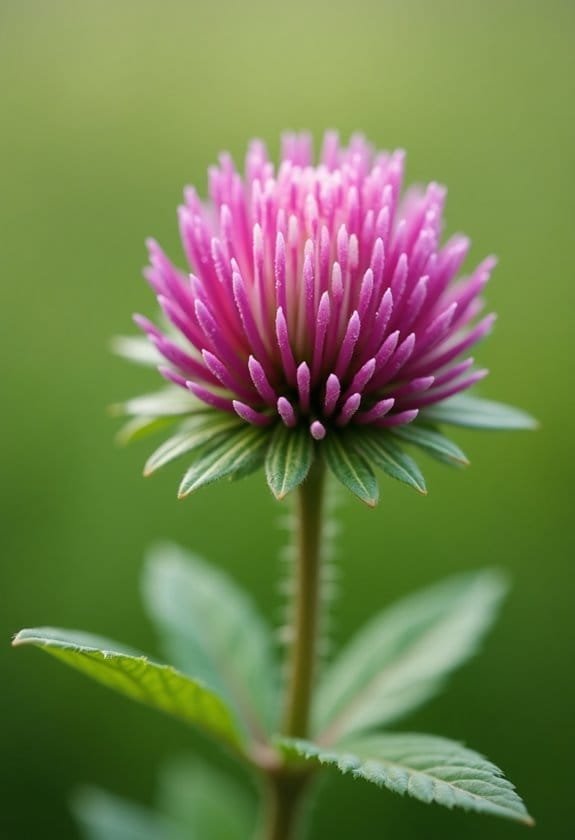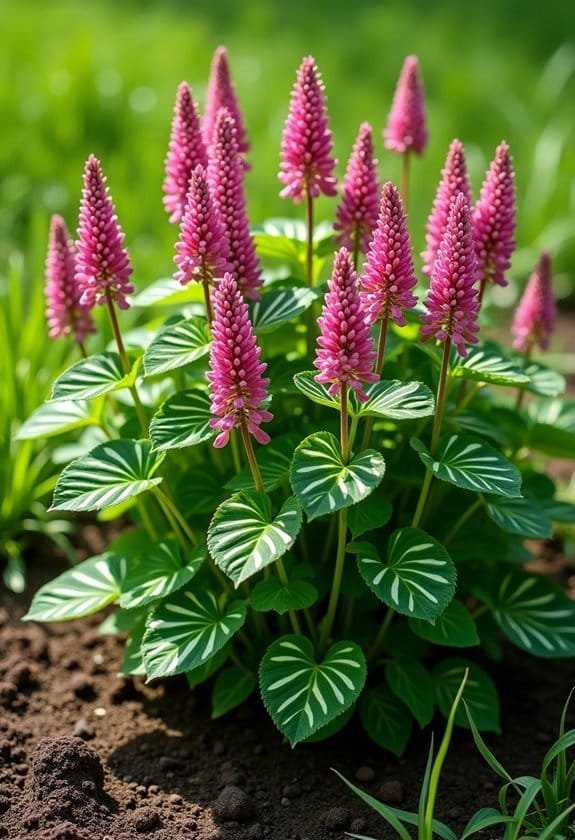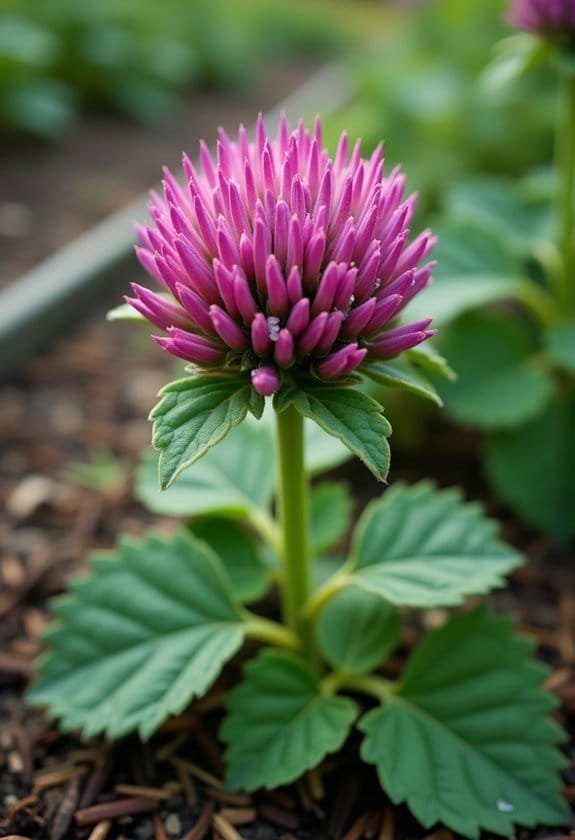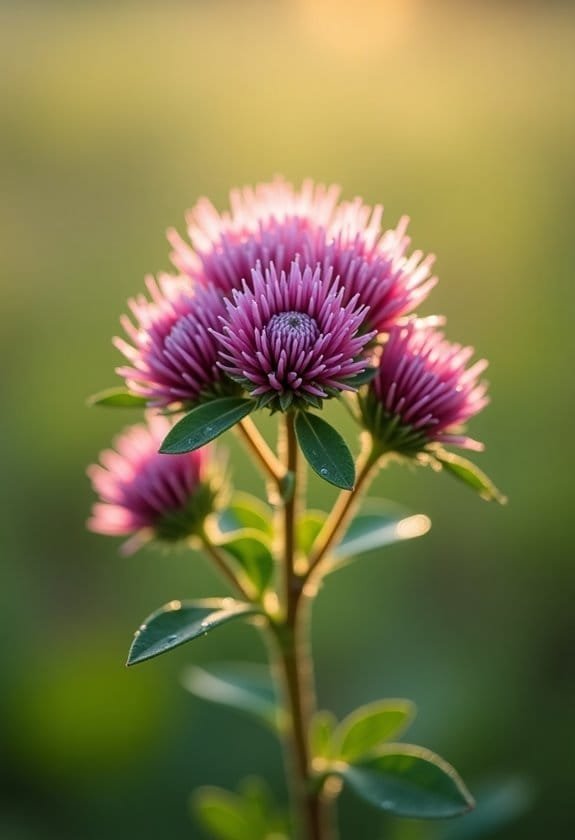Red clover (Trifolium pratense) is a versatile perennial legume that's revolutionizing sustainable agriculture with its remarkable nitrogen-fixing abilities. The plant grows 20-80 cm tall, featuring distinctive dark pink flower heads and trifoliate leaves that make it easily identifiable in fields and meadows. It's prized for both its agricultural benefits, including soil enhancement and erosion control, and its medicinal properties linked to high isoflavone content. This hardy species thrives in well-drained, loamy soils with a pH of 6.0-7.0, attracting essential pollinators like bumblebees while serving as a valuable cover crop. The plant's multifaceted nature offers countless possibilities for those seeking sustainable farming solutions.
Main Points
- Red clover is a pink-flowered perennial legume that grows 20-80 cm tall and features distinctive three-leaflet leaves.
- The plant naturally fixes nitrogen in soil, making it valuable for sustainable agriculture and soil improvement.
- It contains isoflavones with potential health benefits, particularly for menopausal symptoms, though research remains ongoing.
- Red clover thrives in well-drained soils with pH 6.0-7.0 and requires 25-30 inches of annual rainfall.
- As a pollinator-friendly plant, red clover attracts bees and beneficial insects, supporting local biodiversity and ecosystem health.
Introduction

Red clover (Trifolium pratense) stands as one of the most versatile perennial plants in the legume family, widely recognized for its distinctive dark pink flowers and three-part leaves.
Native to Europe, Western Asia, and northwest Africa, this hardy plant has established itself as a valuable agricultural resource, reaching heights between 20 to 80 centimeters with its robust taproot system.
Beyond its role as a forage crop, red clover has earned significant attention in both traditional medicine and modern research for its rich concentration of bioactive compounds, particularly isoflavones, which offer various potential health benefits.
Common Name
This versatile plant's common name, red clover, belies its actually pink-purple blossoms, yet it has become widely known by several distinctive monikers including Cow Grass, Peavine Clover, and Purple Clover.
The flowering plant's scientific designation, Trifolium pratense, offers a more precise identification, with "trifolium" accurately describing its characteristic three-leafed structure.
The disconnect between the common name "red" clover and its true pink-purple coloration demonstrates how vernacular names can sometimes lead to misconceptions about a plant's appearance.
Despite this chromatic confusion, the name has persisted throughout agricultural history, becoming deeply embedded in farming traditions worldwide.
The various common names reflect the plant's widespread utility, particularly in livestock farming, where it serves as valuable fodder.
Each regional name emphasizes different aspects of the plant's character: "Cow Grass" highlighting its importance as cattle feed, "Peavine Clover" describing its growth habit, and "Purple Clover" offering a more accurate color description.
These diverse names showcase the plant's cultural significance across different farming communities and geographical regions.
Scientific Name
Building on its familiar names, the scientific classification provides a more precise way to identify this remarkable plant. Known formally as Trifolium pratense, this species was first documented by the renowned botanist Carl Linnaeus in his groundbreaking 1753 work, Species Plantarum. The genus name Trifolium reflects its characteristic three-leaflet structure, while pratense refers to its meadow habitat.
As a member of the Fabaceae family, red clover shares important genetic traits with other legumes, including peas and beans, highlighting its agricultural significance. This herbaceous perennial has been classified into three distinct subspecies: subsp. baeticum, subsp. kotulae, and subsp. pratense, each adapted to specific environmental conditions.
The plant typically reaches heights between 20 and 80 centimeters, producing dense inflorescences of dark pink flowers that measure 12 to 15 millimeters in length. Despite its common name suggesting red blooms, the flowers actually display a rich pink hue, demonstrating how scientific classification often provides more accurate descriptions than vernacular names.
Overview
Throughout history's agricultural landscape, Trifolium pratense has emerged as one of the most versatile and valuable flowering plants, serving multiple roles in both farming and traditional medicine. This remarkable species, commonly known as red clover, has established itself as a cornerstone of sustainable agriculture, particularly through its ability to enhance soil fertility and prevent erosion in diverse farming systems.
Native to Europe, Asia, and northern Africa, red clover (Trifolium pratense) has expanded its presence globally, demonstrating remarkable adaptability to various climates and agricultural conditions. The plant's distinctive dark pink flowers not only create vibrant displays across meadows but also attract essential pollinators, contributing notably to local ecosystem health and biodiversity.
Beyond its ecological significance, red clover has garnered attention in the medical community for its rich concentration of phytoestrogens, making it a popular natural alternative for managing menopausal symptoms. While traditional healers have long utilized this plant for treating various conditions, including osteoporosis and respiratory issues, modern research continues to explore its potential therapeutic applications, though scientific validation remains an ongoing process.
Key Features
Red clover stands as a robust perennial plant, reaching heights between 20-80 centimeters with its distinctive trifoliate leaves and deep taproots.
Its most striking features include the dark pink flowers, which measure 12-15 millimeters in length and cluster together in dense, honey-scented inflorescences.
The plant displays its full splendor from late spring through early summer, when the blooms create vibrant patches across fields and meadows, while its leaves showcase characteristic chevron markings that distinguish it from other clover species.
Growth Size
A remarkable perennial herb, red clover reaches heights of 20-80 cm (8-31 in) and spreads between 0.67-1.67 ft wide. Its growth habit is characterized by a robust deep taproot system, which enables the plant to withstand challenging drought conditions and establish a strong foundation in various soil types.
The plant's structural development showcases its impressive architectural design, with alternate trifoliate leaves measuring 15-30 mm (0.6-1.2 in) in length adorning its stems. These leaves create an elegant canopy that supports the plant's striking inflorescences, which feature densely packed dark pink flowers measuring 12-15 mm (0.5-0.6 in) each.
Red clover's expansive growth pattern is further enhanced by its vigorous rhizome system, which contributes considerably to its ability to colonize new areas. These underground stems facilitate the plant's natural spreading tendency, allowing it to establish substantial colonies in favorable conditions.
While this aggressive growth pattern makes it an excellent option for ground cover and forage, it can sometimes lead to invasive behavior in certain environments where growth conditions are particularly suitable.
Appearance
Beyond its impressive size and spread, the distinctive appearance of red clover makes it instantly recognizable in fields and gardens. This herbaceous plant's most striking features are its dense, globular flower heads, which showcase deep pink blooms measuring 12-15 mm in length and emit a delightful honey-like fragrance.
The foliage presents another distinguishing characteristic, with its alternate arrangement of trifoliate leaves displaying prominent chevron markings. Each leaflet extends 15-30 mm in length, creating an elegant layered effect that complements the plant's overall structure. The leaves release a characteristic clover scent, adding to the plant's sensory appeal.
The plant's appearance changes through the growing season, reaching its peak visual impact during the flowering period from late spring to early summer. During this time, the robust stems support multiple flower heads, creating magnificent displays that serve as natural beacons for pollinators.
The combination of dark pink blooms against the green foliage creates a striking contrast that enhances the plant's ornamental value in both cultivated and natural settings.
Flowering Season
During late spring, vibrant pink blooms emerge across meadows and fields as red clover enters its peak flowering season. The plant's distinctive dark pink flowers, measuring 12-15 mm in length, cluster together in dense inflorescences that rise impressively to heights between 20-80 cm above the ground.
The flowering season serves multiple significant functions in red clover's life cycle and ecological role. As the plant displays its colorful blooms, it attracts essential pollinators, particularly the specialized Bombus ruderatus, which plays a fundamental role in ensuring successful reproduction. These industrious insects navigate between the tightly packed flowers, facilitating cross-pollination throughout the early summer months.
This period of flowering coincides with red clover's maximum potential as a forage crop, offering peak nutritional value for grazing livestock. The timing is particularly important as the plant actively fixes nitrogen during this phase, enriching the soil through its extensive root system.
As summer progresses, the flowering heads maintain their vibrant appearance, creating a sustained resource for both agricultural purposes and local wildlife populations.
Growing Requirements

Red clover's success hinges on its carefully balanced growing requirements, with the plant thriving in well-drained, loamy soils that maintain a pH between 6.0 and 7.0.
While it demonstrates remarkable adaptability in light conditions, from full sun to partial shade, the plant's deep taproot system enables it to withstand moderate drought conditions while still requiring consistent moisture for ideal growth.
These hardy perennials flourish in temperatures typical of temperate zones, making them particularly suited to spring and late summer plantings when soil temperatures support robust root development.
Light
Successful cultivation of this nitrogen-fixing plant requires full sun exposure, with a minimum of six hours of direct sunlight daily for ideal growth and flowering. Red clover's relationship with sunlight directly influences its ability to develop robust stems, abundant foliage, and vibrant blossoms, making adequate light an essential factor in its cultivation success.
While the plant demonstrates some tolerance for partial shade conditions, reduced light exposure markedly impacts its overall performance and health. In less-than-optimal light conditions, red clover often exhibits elongated, weaker stems and diminished flowering, compromising both its ornamental value and agricultural benefits.
The plant's photosynthetic processes, which are optimized in full sun conditions, play a critical role in developing its characteristic deep taproot system, enhancing drought resistance and soil stability. Additionally, adequate light exposure works synergistically with soil pH requirements, as proper illumination helps the plant efficiently utilize nutrients within its preferred 6.0 to 7.0 pH range, resulting in healthier growth patterns and more productive flowering cycles.
Soil
Growing healthy red clover depends heavily upon well-drained, fertile soil conditions with a pH range of 6.0 to 7.0. Before planting, soil testing is essential to guarantee these ideal conditions are met, as the plant's success hinges on proper soil chemistry and structure.
Red clover demonstrates remarkable adaptability to various soil types, particularly thriving in sandy and loamy compositions, though it strongly resists waterlogged environments. The plant's deep taproot system requires consistent soil moisture to support effective nitrogen fixation, especially during its establishment phase. This natural process greatly enhances soil fertility, making red clover an invaluable component in sustainable agriculture.
To maximize soil health benefits, regular incorporation of organic matter and compost proves vital, as these amendments enhance both nutrient availability and soil structure.
When integrated into crop rotation systems, red clover serves as a powerful soil-building tool, acting like a natural engineer that improves soil composition while preventing erosion. The plant's ability to cycle nutrients efficiently makes it an exceptional choice for farmers seeking to enhance their soil's long-term productivity and sustainability.
Water
Water management plays a significant role in cultivating robust red clover stands, with the plant requiring consistent moisture levels throughout its growth cycle. For ideal development, red clover thrives in conditions that provide 25-30 inches of annual rainfall or equivalent irrigation, guaranteeing steady growth without overwhelming the root system.
While red clover's deep taproot system enables it to withstand periodic dry spells, the plant's sensitivity to waterlogged conditions demands careful attention to drainage. Excessive moisture can trigger root rot and fungal infections, potentially compromising the entire stand's health.
During the essential germination and establishment phases, maintaining balanced soil moisture becomes particularly vital for successful development.
The flowering stage represents a significant period when water management directly influences seed production and overall vigor. Growers must strike a delicate balance, providing sufficient moisture while avoiding oversaturation.
Regular monitoring of soil moisture helps prevent both drought stress and waterlogging, allowing the plant to channel its energy into robust growth and abundant flower production. This careful equilibrium guarantees the stand's long-term sustainability and productivity.
Temperature
Temperature ranges play an essential role in red clover's development, with ideal growth occurring between 15°C to 25°C (59°F to 77°F). This hardy legume demonstrates remarkable resilience across various temperature conditions, making it a versatile choice for temperate climate agriculture.
For peak growth, red clover requires well-drained soils and specific soil temperatures during its germination phase. Seeds typically emerge within 7 to 14 days when soil temperatures maintain a range of 10°C to 20°C (50°F to 68°F), creating an ideal environment for successful establishment.
The plant's adaptability to different soil types becomes particularly evident in its temperature tolerance, as it can withstand frost conditions down to -15°C (5°F).
While red clover shows impressive cold hardiness, excessive heat can pose challenges to its development. The plant's performance may decline in hot conditions, particularly when combined with insufficient moisture.
To maximize growth potential, farmers often consider soil pH levels between 6.0 and 7.0, which work in concert with appropriate temperature conditions to support robust plant development throughout the growing season.
Pollinator Criteria
Red clover stands as an essential resource for numerous pollinator species, particularly attracting diverse bee populations and the specialized Bombus ruderatus.
The plant's dark pink inflorescences serve as beacons for pollinators, offering abundant nectar rewards that sustain these beneficial insects throughout the critical late spring to early summer period.
Through cross-pollination facilitated by these insect visitors, red clover maintains genetic diversity while simultaneously supporting the broader agricultural ecosystem's resilience and productivity.
Attracted Pollinators
Numerous pollinators are drawn to red clover's honey-like fragrance and abundant nectar resources, making it an indispensable plant for supporting biodiversity. The plant's dense, dark pink inflorescences serve as crucial feeding stations for various beneficial insects, particularly during the critical late spring to early summer period. Among these visitors, the Bombus ruderatus bumblebee demonstrates a remarkable dependence on red clover's nutritional offerings in regions where both species coexist.
The plant's architectural structure creates an intricate microhabitat that supports a diverse ecosystem of pollinating insects. Its trifoliate leaves provide shelter, while the clustered flower heads offer easily accessible landing platforms for foraging insects.
The combination of visual appeal and nutritional rewards makes red clover particularly effective at attracting both generalist and specialist pollinators. Additionally, the plant's role as a cover crop enhances soil quality, creating a ripple effect that strengthens the entire pollinator network.
This multifaceted support system demonstrates how red clover functions as a cornerstone species in maintaining healthy pollinator populations within agricultural and natural landscapes.
Pollination Method
The intricate process of red clover pollination depends heavily on specialized insect visitors, with bumblebees serving as the primary facilitators. Within this sophisticated relationship, the European bumblebee (Bombus ruderatus) has emerged as the most efficient pollinator, particularly in regions where red clover has been introduced as a cultivated crop.
The success of pollination relies on the precise timing between the plant's flowering period and pollinator activity, typically occurring during the warmer months from late spring through early summer.
Red clover's tubular flower structure creates a specialized pathway that guides pollinators to collect both nectar and pollen, ensuring effective cross-pollination as the insects move between plants. This methodical process is essential for robust seed production and maintaining genetic diversity within red clover populations.
The presence of diverse pollinator communities greatly enhances pollination efficiency, with studies showing marked improvements in seed yield when multiple species are present.
Each visiting pollinator contributes to the transfer of genetic material, though bumblebees remain the most effective due to their size, behavior, and ability to navigate the flower's complex structure.
Care & Maintenance

Successful red clover cultivation begins with proper soil preparation, including pH testing to confirm levels fall between 6.0 and 7.0 for ideal growth conditions.
Regular maintenance involves strategic mowing after flowering periods, combined with consistent moisture management to support the plant's deep taproot system.
Farmers and gardeners can maximize their red clover's potential by implementing companion planting strategies with compatible crops, while maintaining vigilant monitoring for common diseases like clover rot and rust.
Planting Tips
Growing red clover successfully requires attention to several key planting factors. For ideal results, select well-drained, loamy soils with a pH range between 6.0 and 7.0, ensuring the planting site receives full sun to partial shade exposure throughout the growing season.
Before sowing, it's vital to prepare the soil thoroughly by tilling to a minimum depth of 6 inches, which creates an excellent environment for root development and proper soil moisture retention.
The timing of planting plays a significant role in establishment success, with early spring or late summer being the most favorable periods for seed distribution at a rate of 4-10 pounds per acre.
Maintaining consistent soil moisture is essential during the critical establishment period, which typically spans 2-3 weeks after seeding. While the plants are taking root, implement a regular monitoring schedule to detect potential issues like clover rot or red clover rust early on.
To minimize disease pressure in subsequent growing seasons, incorporate crop rotation strategies into your long-term management plan, allowing the soil to recover between clover plantings.
Ongoing Care
Maintaining healthy red clover stands requires consistent attention to several key maintenance practices throughout the growing season. Regular monitoring plays a vital role in identifying and managing diseases like clover rot and red clover rust, which can devastate plant populations if left unchecked.
Proper soil moisture management is essential for peak growth, as red clover's deep taproot system helps it endure dry periods, though supplemental watering may be necessary during extended droughts.
When used as a cover crop, red clover contributes greatly to soil fertility and structure improvement, making it an invaluable component of sustainable farming systems.
To prevent unwanted spread, particularly in regions where red clover can become invasive, it's important to implement strategic flower cutting before seed formation occurs.
Agricultural professionals recommend incorporating red clover into crop rotation systems, which not only enhances soil fertility but also disrupts pest lifecycles.
This approach, combined with careful disease management protocols, helps maintain the health and productivity of red clover stands while maximizing their benefits to overall soil quality and agricultural sustainability.
Suggested Companions
The right companion plants can greatly enhance red clover's growth and soil-building capabilities. When selecting companion plants, it's crucial to match their soil requirements and light preferences with red clover's need for well-drained soil and full to partial sun exposure.
Grasses make particularly beneficial companions for red clover, with timothy and orchard grass serving as excellent choices that complement its growth patterns. These companions help strengthen the soil structure while creating a diverse and nutritious forage mix that's particularly valuable for livestock operations.
Another outstanding partner is alfalfa, which works synergistically with red clover to amplify nitrogen fixation in the soil, creating a more fertile growing environment for both species.
However, gardeners should exercise caution when introducing red clover into mixed plantings, as its vigorous self-seeding nature can overwhelm less aggressive species.
To maintain a balanced companion planting scheme, implement regular mowing after flowering periods to control growth and prevent unwanted weed establishment. This management strategy guarantees that both red clover and its chosen companions can thrive together in a harmonious growing environment.
How Does Dandelion Compare to Red Clover in Herbal Uses?
Dandelion and red clover are cherished in herbal medicine, each offering unique qualities. While red clover supports hormonal balance and detoxification, the benefits and uses of dandelion plants include digestion support, liver health, and a rich nutrient profile. Both herbs complement wellness routines with their distinct therapeutic properties.
Common Issues
Red clover faces several significant challenges from diseases like clover rot and red clover rust, which can devastate entire fields if left unchecked.
These pathogens, along with parasitic nematodes and viral infections, require careful monitoring through regular field inspections and soil testing to detect early warning signs.
Effective management strategies include crop rotation, maintaining proper drainage, and selecting disease-resistant varieties, though farmers must also watch for signs of invasive spread in susceptible regions.
Pests/Diseases
Successful cultivation of red clover faces several considerable pest and disease challenges that can impact plant health and crop yields. Among the most devastating pathogens is clover rot, which can severely compromise plant robustness and lead to substantial losses in forage production.
Red clover rust presents another formidable threat, manifesting as distinctive reddish-brown spots on leaves that interfere with photosynthetic efficiency and overall plant strength.
Below ground, parasitic nematodes pose a silent but serious threat to red clover cultivation by infiltrating and damaging root systems, which ultimately results in stunted growth and compromised nutrient absorption capabilities.
The clover yellow vein virus represents a particularly troublesome pathogen that induces chlorosis in leaves and greatly diminishes forage quality, affecting both yield and nutritional value of the crop.
To combat these challenges effectively, farmers and agricultural specialists implement thorough monitoring protocols and integrated pest management strategies, which might include crop rotation, resistant varieties, and carefully timed interventions when necessary.
This systematic approach helps maintain healthy stands and guarantees ideal production levels despite the presence of these common agricultural adversaries.
Solutions
Managing common issues in red clover cultivation requires a detailed approach that builds upon proven pest and disease control strategies. Effective disease management begins with implementing thorough monitoring systems to detect early signs of clover rot and rust infections, allowing for timely intervention.
A multi-faceted solution involves strategic crop rotation practices, which help break disease cycles and reduce the pressure from soil-borne pathogens and parasitic nematodes.
Farmers can improve overall health of their red clover crops by selecting resistant varieties that have been developed through ongoing research into genetic diversity. These improved strains offer enhanced disease resistance and better adaptation to local environmental conditions.
To address the challenge of invasive growth through self-seeding, controlled grazing and regular mowing serve as effective management tools.
Additionally, integrating modern breeding techniques with traditional farming practices has led to the development of varieties that maintain vigorous growth while being less prone to aggressive spreading.
This balanced approach guarantees sustainable red clover cultivation while minimizing its potential to become invasive in sensitive ecosystems.
Summary

A versatile and beneficial plant, Trifolium pratense serves multiple purposes in agriculture, ecology, and potential medicinal applications. This remarkable species, commonly known as red clover, demonstrates significant value through its nitrogen-fixing capabilities, which enhance soil fertility and support sustainable farming practices.
Beyond its agricultural significance, red clover contains bioactive compounds called isoflavones, which function as phytoestrogens in the human body and may provide relief for individuals experiencing menopausal symptoms. While research regarding its therapeutic effectiveness remains inconclusive, the plant continues to attract scientific interest for its potential health applications.
The ecological impact of red clover extends to its role in supporting pollinator populations and preventing soil erosion, making it an integral component of environmental conservation efforts.
However, safety considerations must be acknowledged, as the plant can interact with certain medications and isn't recommended during pregnancy or breastfeeding.
Despite these precautions, red clover remains a valuable resource that bridges the gap between agricultural productivity, ecological sustainability, and potential therapeutic applications in modern healthcare practices.


